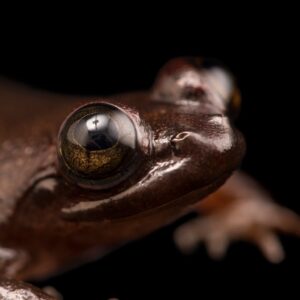
When I first saw a photo of this specie, my initial thoughts were, “okay this is regular frog”, then my eyes gazed upon the name, and I was taken aback for a moment there. I mean, which frog isn’t slippery, why is it named after a country, what is its story, how different is it from the “mundane” ones we hear of, whenever it rains. My thoughts ran wild.
With the help of research, my mind got clearer from all the wonder of what this frog is. Stay with me, as we learn all about the Togo Slippery Frog.
According to a list updated on the 14th of September, 2019, by the International Union For Conservation of Nature, the Togo slippery frog is part of a list of Critically Endangered species in Ghana.
This list was last updated 2019-09-14
This list contains only species that have been assessed for the IUCN Red List. It is therefore not representative of all the species in the country.
Conraua derooi also known as the Togo Slippery Frog is a species of frog in the family Conrauidae. It is found in Togo. A few populations were found in surveys in 2005–2007, after the species had gone unrecorded for more than 20 years.
The specific name derooi honours Antoon De Roo, a Belgian ornithologist who was part of the expedition that discovered the species.
Conraua derooi are large frogs (though much smaller than their relative, the goliath frog Conraua goliath), with males measuring 76–84 mm (3.0–3.3 in) and females about 74–82 mm (2.9–3.2 in) in snout–vent length. The head is relatively large with prominent eyes and a fairly small snout. The tympanum is not visible externally. The hindlimbs are very long and robust. The toes are long and have distinct adhesive discs and webbing extending midway to the discs. The forelimbs are short but muscular with webbed fingers.
The Togo slippery frog lives in flowing water in forest habitats, and are permanently aquatic.
At the time of the latest assessment by the International Union for Conservation of Nature (IUCN) in 2004, only one surviving population was believed to exist. Nevertheless, the species is extremely threatened by habitat destruction and alteration, as well as by human consumption.
Genetic differentiation between the Atewa and Volta populations, can be seen. It is said that, populations within the Atewa Range Forest Reserve seem large and viable; which are probably the largest remaining populations.
What blew my mind was the realization after reading a few articles that, this small and powerful amphibian is part of a family that goes back 70 to 80 million years, to the time of the dinosaurs. The Togo slippery frog ranks 18th in the hundred most genetically distinct and critically endangered in the world.
Although it’s a close relative of the Goliath bullfrog, the biggest in the world, the adult Togo slippery frog only grows to be three inches long. Unlike many other frogs, its eardrums are not visible on its head. The male Togo slippery frog’s eardrums are also larger than females, which is unusual for frogs. It has long and limber hind legs that it uses to propel itself into the water at the first sign of danger.
Why Is It Critically Endangered?
For decades, the Togo slippery frog was feared extinct. Now, experts estimate that there are only about 240 left, and the species is classified as critically endangered.
Its disappearance is the result of human activity destroying its habitat. Much of its forest habitat has been cleared out by logging for wood, hunting, fishing, and the expansion of farming and housing.
Human activities have also contributed to increased pollution and landslides, which have decreased the quality of the water in the streams that Togo slippery frog relies on for breeding and raising its tadpoles. Furthermore, local communities use the water from these streams for their own purposes, which reduces the quantity and quality of the water.
It is believed that people moved to this region 5,000 years ago specifically because of the availability of edible frogs, such as the Togo slippery frog. The species is still eaten today.
Conservation
A leading herpetologist, Caleb Ofori-Boateng, has founded the NGO Herp Conservation Ghana to raise awareness of the danger that the species faces. His organization works with communities that live in and near the frog’s habitat to plant trees, replacing those that have been cut down. These efforts are said to create the first forest area in West Africa specifically made to protect frogs. Herp Conservation Ghana has also installed more sustainable systems for getting water, such as rainwater collection, so communities don’t have to take as much from the streams the frog lives in.
SOURCES: https://www.nationalgeographic.com/animals/amphibians/facts/togo-slippery-frog
IUCN SSC Amphibian Specialist Group (2020). “Conraua derooi”. IUCN Red List of Threatened Species. 2020: e.T58253A16281365.
PC: Joel Sartore.




